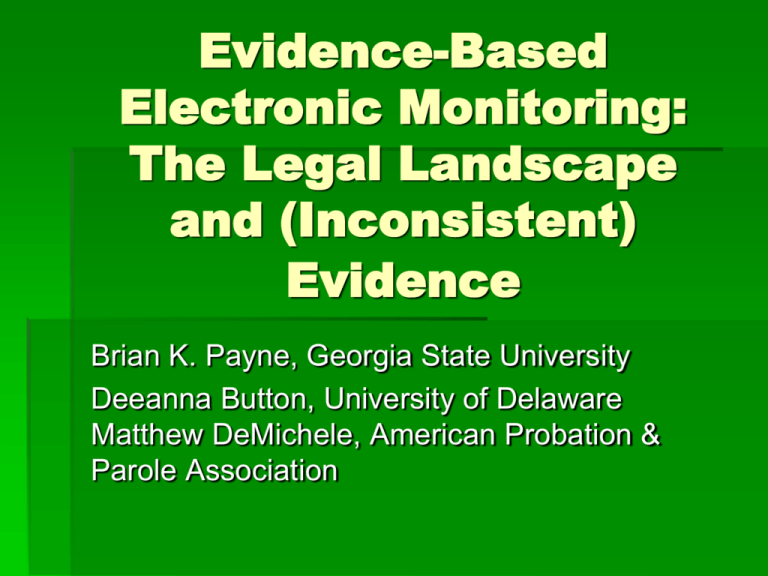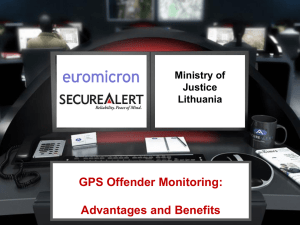Sexual Assault - American Probation and Parole Association
advertisement

Evidence-Based Electronic Monitoring: The Legal Landscape and (Inconsistent) Evidence Brian K. Payne, Georgia State University Deeanna Button, University of Delaware Matthew DeMichele, American Probation & Parole Association Objectives 1.Discuss how laws effecting the use of electronic monitoring tools have shifted, especially to incorporate location tracking with GPS. 2.Discuss how these legislative changes have implications for the way community corrections officers supervise offenders. 3.Provide information about the effectiveness of electronic monitoring tools. Evidence-Based Electronic Monitoring of Sex Offenders [cont.] Technology Rapidly evolving Legislation = active GPS Technology is one more tool Combined with others Means to end = structured containment Not the end Provides WINDOW into offender’s life Evidence-Based Electronic Monitoring of Sex Offenders [cont.] Many electronic tools to supervise offenders Technology Radio frequency Location tracking Computer monitoring and forensics Crime and GPS data integration Polygraph Others Radio Frequency: Martha Stewart’s Model Radio Frequency Radio Frequency [cont.] Home arrest Curfew monitoring Judge Love (Albuquerque, NM) 1983 By 1990 in 50 states Several countries Repairs False positives of violations Radio Frequency [cont.] Drive-by units Random calling Identity verification Slow scan photos Electronic voice analysis Remote alcohol detection (late 1980s) Location Tracking Location Tracking Late 1990s Cellular Technology 24 Satellites U.S. Department of Defense [cont.] Location Tracking Active and Passive Exclusion Zones Workload Differences Liability Legislation [cont.] Benefits of Using GPS Flexibility Reintegration Control Retribution Benefits of Using GPS Flexible Can be applied to different types of offenders Sex offenders Burglars Domestic violence offenders Gang members Benefits of Using GPS Reintegration Offenders are able to live at home Maintain employment Avoid criminogenic conditions related to incarceration Benefits of Using GPS Control Capacity to effectively control offenders via: Inclusion and exclusion zones Curfews Data points show offender’s daily movements Is he/she spending time at McDonald’s (playground)? Or why is he/she spending so much time at the Mall (kid’s stores)? Benefits of Using GPS Retribution Deprivation of autonomy Deprivation of goods and services Deprivation of liberty Deprivation of intimate relations Monetary costs Family effects Watching others Bracelet effects Cost of Using GPS Seemingly cost effective GPS: $10 per day Incarceration: $60 per day Civil confinement: $110,000 per year Cost of Using GPS Incarcerated populations remain the same Community corrections populations continues to grow GPS is an additional cost Cost of Using GPS Estimated GPS cost $9,000 a year per sex offender Actual cost: Tennessee: $2.5 million a year for 650 offenders Iowa: $2.4 million a year for 500 offenders Fees pay for technology Fees do NOT pay for the workload Legislation Political Fears Stems from media driven frenzy Agenda driven politicians Frightened and concerned citizens Unanticipated Effects Fails to consider legislation’s impact on criminal justice administrators and practitioners Legislation for Effective Community Corrections Policy 47 states have EM legislation 14 states have legislation describing GPS for sex offenders 7 states use either active or passive systems 8 states require the use of active electronic monitoring Legislation for Effective Community Corrections Policy 18 states clearly define use of EM 29 states require offenders to pay at least a portion of EM fees 17 states regulate the amount of time offenders spend on EM 11 of these states stipulate time limits for general EM devices 7 of these states place specific time limits for GPS supervision Legislation for Effective Community Corrections 27 states have specific policies for monitoring sex offenders 19 states require EM for sex offenders Only three states mention EM use for domestic violence offenders Four states use EM for convicted drug and alcohol offenders Legislative Typologies General vs. Specific Sentence Integration Risk Assessment Punitive Evaluation Offender Fees Child Abuse Repeat Offenders General vs. Specific Policies General Policies Lack precise definition of EM expectations Neglect to mention Type of offender Length of time to be monitored Mandatory technological capabilities General vs. Specific Policies General Policies (examples) Pennsylvania: Individuals eligible for house arrest involving EM shall be determined by administrative staff Utah: In determining its sentence the court…may require the defendant to participate in an EM program General vs. Specific Policies Specific Policies More specific in policy stipulations More likely to mention Type of offender Length of time to be monitored Mandatory technological capabilities General vs. Specific Policies Specific Policies Florida: Requires that offenders who are designated sexual predators must upon release and for the rest of their life be subject to GPS Indiana: Requires a sexually violent predator be placed on lifetime parole to be monitored via GPS device. Amends definition of “monitoring devices” to include those that provide 24 hour information on an offender’s location, and capable of notifying appropriate officials of offender’s violation Sentence Integration Integrate EM into the offender’s sentence Kansas, Louisiana, and Maine: Mandatory prison sentences in addition to required lifetime electronic monitoring Michigan: Requires a term of 25 years without possibility of parole [and] requires lifetime electronic monitoring…” Risk Assessment Risk assessments to determine the probability of offender recidivism Provisions of sexually dangerous: Seriousness of the assault Age of the victim Number of prior offenses Risk Assessment Review boards used to assess sexual dangerousness of offender Louisiana, New Mexico, and Connecticut Georgia: requires GPS monitoring if Sexual Offender Registration Review Board deems and offender “sexually dangerous” Risk Assessment EM utilized according to risk Categorized to one of three levels Risk of repeat offense Risk to public safety Violent predator status Montana: GPS monitoring must be imposed upon “level 3 sex offenders” Illinois: requires those convicted of an offense that would qualify the accused as a sexual predator be subject to EM Punitive Nature of Policies Used as Additional form of long term punishment Florida: Sexual offenders Upon release and for the rest of their life Subjected to GPS “active electronic monitoring” South Carolina: Electronic geographical location monitoring Offenders who violate terms of community supervision Used as additional punitive sanction Evaluation of Policies Data collection required to evaluate sex offender electronic monitoring legislation Illinois and Kansas: statistical information on numbers of offenders required to register who are subject to electronic monitoring Indiana: mandates reports on cost and implementation issues of GPS monitoring, including feasibility of recovering expense of GPS from offenders Reliance on Offender Fees Offenders must pay for monitoring Or a portion of fees Georgia, Michigan, Oklahoma, Tennessee… Exceptions mentioned Louisiana and Alaska Unanticipated Consequences Realistic Workload Child Abusers Victim age Specific vs. General “crimes against children under age 14” “particularly those against children” Mandatory terms Mandatory sentence length Mandatory conditions Child Abusers Georgia: Minimum sentence 25-50 years or life Particularly for forcible crimes against children under age 14 Florida: sex crimes particularly those against children upon release and for the rest of their life be subject to GPS Wisconsin: lifetime GPS tracking probation for committing a serious child sex offense Repeat Offenders Severe sentences for repeat offenders Kansas First-time offenders: minimum 25 year sentence without parole Second-time offenders: minimum 40 year sentence without parole Third-time offenders: life without parole Michigan and Iowa Second-time offenders: life without parole South Carolina Second-time offenders: death penalty for sex crimes against a child less than 11 years of age Legislation and Electronic Monitoring The use of GPS to monitor sex offenders represents perhaps the most comprehensive form of legislation that has been passed Legislation and EM: Unanticipated Consequences EM of sex offenders is recent legislative concern Policymaking community blurring issues of electronic monitoring and sex offenders The use of these policies to control sex offenders continues to increase despite the lack of empirical research supporting such growth One more Tool (not the only tool) Legislation and Electronic Monitoring Electronic monitoring of sex offenders result of: Growing political and public concern about sex offenders Technological shifts Evolving template of state sex offender laws Expectations of Community Corrections Rehabilitate and punish offenders Free up jail and prison space Reduce Cost Ensure offender compliance through Treatment Enforcement Surveillance Expectations are difficult to fulfill EM is not a program, but a tool EM contributes to information gathering Information about the offender EM does not reduce the human component Where’s the Evidence? Does electronic monitoring work? Does electronic monitoring reduce recidivism? Does electronic monitoring improve case management? How do we know? Where’s the Evidence? [cont.] Little research - weak methodologies Mixed results Better for some populations Differences across types of offenders What is purpose of electronic monitoring? Punishment? Accountability? Behavior change? Where’s the Evidence? [cont.] Not a FIX Electronic Monitoring does not replace OFFICER ONE Tool Incorporated with other TOOLS Create highly structured CONTAINMENT Evidence [cont.] Finn and Muirhead Steves (2002) High-risk male parolees Electronic monitoring showed no impact after four years Sex offenders on electronic monitoring Less likely to return to prison Longer survival in community Evidence [cont.] Bonta, Wallace-Capretta, & Rooney (2000) Electronic Monitoring + Treatment LOWER recidivism for high-risk No effect on lower risk Match offender to interventions Low-risk in high-risk setting More recidivism Evidence [cont.] Padgett, Bales, & Blomberg 75,661 (RF and GPS) Electronic monitoring of offenders in the community may prove an effective public safety alternative to prison Evidence [cont.] Technical violation RF = 95.7% less likely GPS = 90.2% less likely SO = slightly less likely Absconding RF = 91.2% less likely GPS = 90.2% less likely SO = 42% less likely Revocation for new crime RF = 95% less likely GPS = 95% less likely SO = 44.8% less likely GPS for Violent Offenders: Some Concerns Lack of research Workload Net-widening False sense of security Responsiveness to characteristics of violent offending Sanction’s responsiveness to the motivations for offending GPS for Violent Offenders: Some Concerns Stigma and degree of control Redefining the justice orientation Legal issues Cost of using GPS GPS for Violent Offenders: Some Concerns Establish purpose of GPS monitoring policies Clearly defined goals make successful implementation more probable Do not over-estimate actual abilities of technology GPS for Sex Offenders: Some Concerns Recognize that policies may have unintended negative consequences and be prepared with appropriate remedies GPS for Violent Offenders: Some Concerns Zero tolerance policies should be avoided Training Funding Probation and parole officers should expect dramatic workload increases Must maintain physical contact and “intense scrutiny” Must take all alerts seriously GPS for Violent Offenders: Some Concerns Collaborative effort is required Law Enforcement Jails/Prisons Probation and parole officers are NOT solely responsible for sex offending prevention GPS for Violent Offenders: Some Concerns More criminological research in this area Research should focus on Sex offenders and strategies to control them Officer and Offender interaction: How do GPS policies affect this interaction? Unanticipated Consequences of Monitoring Policies for Sex Offenders False sense of security Sanction stacking Restructured workloads Anomic conditions in the electronic monitoring program Isolation Unanticipated Consequences of Monitoring Policies for Sex Offenders False sense of security EM policies may not be providing direct protection to the community 95% of all sex crimes involving a victim less than 18 years of age involve a known offender Unanticipated Consequences of Monitoring Policies for Sex Offenders Sanction stacking Occurs when probationers and parolees are exposed “to a number of punitive and rehabilitative controls, which often leads to violations and returns to the correctional system” Unanticipated Consequences of Monitoring Policies for Sex Offenders Restructured workloads GPS supervision increases per offender workload by lengthening the enrollment phase for an offender Time spent informing the offender with various operation and technological concerns Time spent fitting, cleaning, replacing, maintaining equipment Unanticipated Consequences of Monitoring Policies for Sex Offenders Anomic conditions in the electronic monitoring program The potential for normlessness in officer caseloads escalates with unrealistic expectations and lack of guidance One problematic offender will make it difficult to supervise other offenders Officer confusion Unanticipated Consequences of Monitoring Policies for Sex Offenders Isolation Potential to push officers further away from face-to-face interaction with offenders Brutalization Effect Offenders may perceive the controlling nature of GPS in negative ways and react aggressively as a result of the sanction Implications of Current Legislation and Evidence General vs. Specific Policy States with specific policies may have dramatically increased workloads Implications of Current Legislation and Evidence Sentence Integration Officers will need to expand their abilities to ensure that various types of sentences are administered simultaneously or consecutively Implications of Current Legislation and Evidence Risk Assessment Officers will need to be effectively trained to determine risk Implications of Current Legislation and Evidence Punitive Nature of the Policies Probation is generally seen as rehabilitative and treatment oriented GPS may be most punitive form of probation Implications of Current Legislation and Evidence Evaluation of Policies Officers must be trained to gather appropriate data that will effectively assess the utility of policies Empowerment approach to evaluate policies Implications of Current Legislation and Evidence Reliance on Offender Fees Officers need to make sure offenders are paying for the monitoring Officer will need to work with offenders to make sure they are paying bills Officers must recognize that fees alone will not be enough to pay for GPS Implications of Current Legislation and Evidence Breadth of Offenders Officers will need to be able to deal with a variety of offenders Child perpetrators Young offenders Repeat offenders Implications of Current Legislation and Evidence Implied Causality Narrowly defining cause of sexual abuse may place individuals at risk and be an ineffective use of resources Laws: sex offending is caused by opportunity and availability Research: histories of violence and other factors contribute to sex offenders’ motivations Implications Current Legislation and Evidence Consider workload Repairs and malfunctions Responding to alerts Consider liability Active GPS Constant information Must process information Implications Current Legislation and Evidence Consider offender type Location tracking = high-risk sex offender Curfew monitoring = lower-risk offenders Implications Current Legislation and Evidence Improve performance Short-term management Treatment completion No behavior change Lack long-term Lack cognitive-behavioral adjustment Implications Current Legislation and Evidence Integrate TOOLS Not a panacea Highly structured = external control Containment of offender’s life Overall strategy of ACCOUNTABILITY Legislation Mandating active GPS Recommendations for Probation and Parole Officers Must recognize the diverse nature of offenders Each type of offender poses varying levels of risk and different criminogenic needs Treatment and interventions must be individualized Recommendations for Probation and Parole Officers Must be adequately trained to use electronic monitoring strategies to supervise offenders Recommendations for Probation and Parole Officers Must be a part of a supportive environment that will help overcome the consequences of isolation Must pay attention to potential for burnout Recommendations for Probation and Parole Officers Must work with researchers to validate that response strategies are evidence based Need to utilize strategies that are Proven effective Must have clear expectations for the technology Contact Information Matthew DeMichele American Probation and Parole Association (859) 244-8123 mdemichele@csg.org Brian Payne Old Dominion University bpayne@odu.edu Deeanna Button Old Dominion University dbutton@yahoo.com






